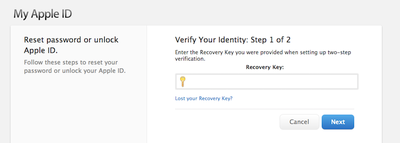In March 2013, Apple introduced two-factor authentication to provide additional security for Apple IDs. It expanded the feature to several new countries earlier this year and introduced it to the company's iCloud.com website this September. This was after CEO Tim Cook promised to broaden use of its two-factor authentication system in the wake of a hacking incident that saw several celebrities' iCloud accounts hacked.

The system requires a user to have a second "trusted" device that is used to verify a user's identity in addition to an extra security code called the "Recovery Key". However, in a new account from The Next Web's Owen Williams, that Recovery Key also has the potential to completely lock a person out of their account if they're being hacked.
Williams found that someone had tried to hack his iCloud account. Apple's two-factor system kicked in and locked the account, denying entry to the would-be hacker while also denying entry to Williams. When he went to iForgot, Apple's account recovery service, he assumed two of his password, Recovery Key or trusted device would unlock his account, as he was led to believe by an Apple Support document.
When I headed to the account recovery service, dubbed iForgot, I discovered that there was no way back in without my recovery key. That’s when it hit me; I had no idea where my recovery key was or if I’d ever even put the piece of paper in a safe place. I’ve moved since I set up two-factor on iCloud.
Williams contends he took a screenshot of the Recovery Key and printed that out as well as taking a photo on his iPhone to keep as a backup, but could not locate either and was on the verge of losing his "digital life". He called Apple customer support and was told that he had forfeited his Apple ID by losing his Recovery Key and that there was no way Apple could help him. He called back a second time.
When she got back on the line, the story was just as bleak. “We take your security very seriously at Apple” she told me “but at this time we cannot grant you access back into your Apple account. We recommend you create a new Apple ID.”
After a couple more days of talking to Apple customer support and even friends who worked at Apple, he continued to receive same responses: he was locked out of his account due to someone trying to hack into it and couldn't unlock it without a Recovery Key even though Apple's support document says it's possible with a trusted device. Eventually, Williams located his Recovery Key in what he calls the "depths" of his Time Machine backup, allowing him to finally unlock his account.
Williams concludes with a warning that anyone with two-factor authentication should take far greater care in protecting and remembering where they store their Recovery Keys, as losing it could permanently lock a user out of their Apple ID with Apple unable to do anything to help. The entire account, which is a fascinating and worthwhile read, can be read at The Next Web.























